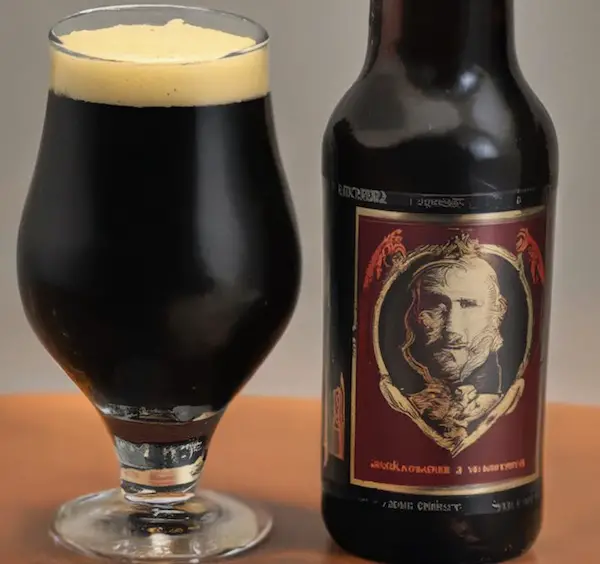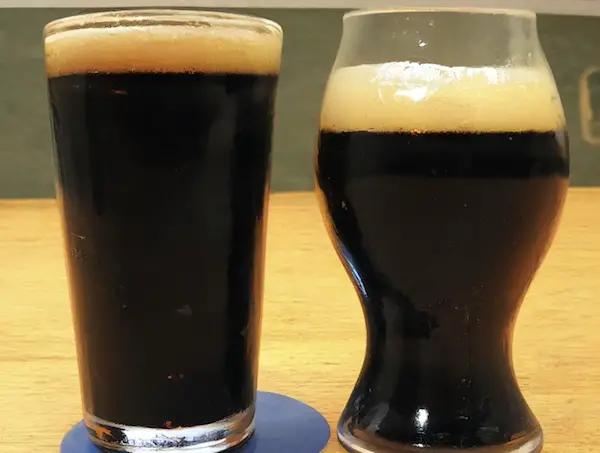As an expert brewer, I often get asked what sets a Russian Imperial Stout apart from an Ordinary Imperial Stout. Both are dark, robust, and complex beers, but they have some key differences that make them distinct from each other.
The key difference between Russian Imperial Stout and Ordinary Imperial Stout lies in their origins and brewing traditions.
Russian Imperial Stouts are bolder in flavor and higher in alcohol content, while Ordinary Imperial Stouts are more balanced and moderate in strength.
In this blog post, we will delve into the world of these two stouts and uncover what sets them apart. We’ll discuss their origins, brewing process, ingredients, alcohol content, flavor profiles, and more. So, grab a pint, and let’s dive in!
1. Origins and History
Russian Imperial Stout
The Russian Imperial Stout, also known as the Imperial Russian Stout or simply the Imperial Stout, has a storied history that dates back to the 18th century.

These beers were first brewed in England for export to the Russian Empire, where they gained favor with the royal court, particularly with Empress Catherine the Great. The high alcohol content and robust flavor of these stouts were well-suited for the harsh Russian winters, and they quickly became popular throughout the country.
Ordinary Imperial Stout
In contrast, the Ordinary Imperial Stout has a more general, less specific origin. It is essentially an evolution of the traditional stout, which has been brewed in various forms for centuries. The name “Imperial” is likely borrowed from the Russian Imperial Stout, but these beers do not have the same direct connection to the Russian Empire.
2. The Brewing Process
Russian Imperial Stout
The brewing process for a Russian Imperial Stout is typically more involved and time-consuming than that of an Ordinary Imperial Stout. The use of higher-quality ingredients and a more extended fermentation and aging process contribute to the depth and complexity of the beer.
1. The brewer begins by mashing an array of dark, roasted malts with a higher concentration of sugars.
2. The mash is then boiled, and a generous amount of hops is added to provide bitterness and balance.
3. The beer is fermented, usually with a high-gravity yeast strain capable of producing higher alcohol levels.
4. After fermentation, the beer is typically aged for an extended period, often in oak barrels, which imparts additional flavors and complexity.
Ordinary Imperial Stout
The brewing process for an Ordinary Imperial Stout is more straightforward, focusing on balance and moderation. While the ingredients and general steps are similar to those of a Russian Imperial Stout, the process tends to be less elaborate.
1. The brewer mashes a mix of dark, roasted malts, but with a lower concentration of sugars than in a Russian Imperial Stout.
2. The mash is boiled, and a moderate amount of hops is added for balance.
3. The beer is fermented using a standard yeast strain.
4. Aging is typically shorter than for Russian Imperial Stouts, and oak barrel aging is less common.
3. Ingredients
Russian Imperial Stout
The ingredients used in a Russian Imperial Stout contribute to the beer’s bold, rich flavors and high alcohol content. Key ingredients include:
1. Dark, roasted malts: These malts give the beer its characteristic dark color and contribute to its rich, chocolatey, and coffee-like flavors.
2. High-gravity yeast: This type of yeast can ferment a higher concentration of sugars, resulting in a higher alcohol content.
3. Generous hop additions: Hops provide bitterness and balance, and Russian Imperial Stouts often use a substantial amount of hops for this purpose.
4. Specialty ingredients: Some brewers may add additional ingredients such as molasses, licorice, or even fruit to enhance the beer’s complexity.
Ordinary Imperial Stout
The ingredients used in an Ordinary Imperial Stout are similar to those of a Russian Imperial Stout, but with some differences in proportions and focus. Key ingredients include:
1. Dark, roasted malts: These malts give the beer its dark color and contribute to its roasted, chocolate, and coffee flavors.
2. Standard yeast: A standard yeast strain is typically used, resulting in a more moderate alcohol content.
3. Moderate hop additions: Hops are used for balance, but the overall hop profile is less aggressive than in a Russian Imperial Stout.
4. Specialty ingredients: While some brewers may add additional ingredients, the focus is typically on balance and moderation rather than bold, intense flavors.
4. Alcohol Content
Russian Imperial Stout
Russian Imperial Stouts are known for their high alcohol content, typically ranging from 8% to 12% ABV (alcohol by volume). This is due, in part, to the use of high-gravity yeast strains and a higher concentration of fermentable sugars in the brewing process.
Ordinary Imperial Stout
Ordinary Imperial Stouts, while still considered strong beers, have a more moderate alcohol content than their Russian counterparts. These beers typically fall in the 6% to 8% ABV range, making them slightly more approachable and easier to drink in larger quantities.
5. Flavor Profile
Russian Imperial Stout
The flavor profile of a Russian Imperial Stout is characterized by its bold, rich, and complex flavors. These beers often have prominent notes of dark chocolate, coffee, and roasted malt, as well as a marked hop bitterness. The aging process can also contribute additional flavors, such as vanilla, oak, and dark fruit, creating a multi-layered and sophisticated taste experience.
Ordinary Imperial Stout
The flavor profile of an Ordinary Imperial Stout is more balanced and moderate than that of a Russian Imperial Stout. While these beers still feature the roasted malt, chocolate, and coffee flavors typical of a stout, they are often less intense and more approachable. The hop bitterness is also more restrained, making for a smoother drinking experience.
6. Appearance and Mouthfeel
Russian Imperial Stout
Russian Imperial Stouts are typically very dark, often appearing almost black in color. They often have a thick, creamy head and a viscous, full-bodied mouthfeel. The high alcohol content can lend a warming sensation on the palate.

Ordinary Imperial Stout
Ordinary Imperial Stouts also have a dark appearance, but they may be slightly lighter in color than their Russian counterparts. The head is typically creamy but may be less dense, and the mouthfeel is generally smoother and more moderate, reflecting the beer’s more restrained flavor profile and alcohol content.
7. Food Pairings
Russian Imperial Stout
Given their bold flavors and high alcohol content, Russian Imperial Stouts pair well with rich, hearty dishes and strong cheeses. Some excellent pairings include:
1. Braised short ribs
2. Beef stew
3. Dark chocolate desserts
4. Roquefort or Stilton cheese
Ordinary Imperial Stout
The more balanced flavors and moderate alcohol content of Ordinary Imperial Stouts make them suitable for a wider range of food pairings. Some delicious options include:
1. Grilled meats
2. Roasted vegetables
3. Chocolate or coffee-flavored desserts
4. Cheddar or Gouda cheese
8. Aging and Cellaring
Russian Imperial Stout
Russian Imperial Stouts are known for their aging potential, with many examples improving and developing in complexity over time. The high alcohol content acts as a preservative, allowing these beers to be cellared for years or even decades. Oak barrel aging is also common, which can further enhance and transform the beer’s flavor profile.
Ordinary Imperial Stout
While Ordinary Imperial Stouts can also be aged, their more moderate alcohol content and less complex flavor profiles generally make them better suited for shorter-term cellaring. Aging these beers for a few months to a year can still result in some interesting flavor developments, but they are less likely to benefit from extended aging periods.
9. Availability and Popularity
Russian Imperial Stout
Despite their niche origins, Russian Imperial Stouts have become increasingly popular among craft beer enthusiasts in recent years. Many breweries now produce their own versions of this bold, complex beer style, and they can often be found in specialty bottle shops and craft beer bars.
Ordinary Imperial Stout
Ordinary Imperial Stouts, while perhaps less sought-after than their Russian counterparts, are still a popular and widely available beer style. Many breweries produce these more approachable stouts, and they can be found at most bars and bottle shops that carry a diverse selection of craft beers.
Conclusion
In conclusion, the key difference between Russian Imperial Stout and Ordinary Imperial Stout lies in their origins and brewing traditions. Russian Imperial Stouts are bolder in flavor and higher in alcohol content, while Ordinary Imperial Stouts are more balanced and moderate in strength. Here are 10 quick facts about these two stout styles:
1. Russian Imperial Stouts were originally brewed in England for export to the Russian Empire.
2. Ordinary Imperial Stouts are an evolution of the traditional stout, with no specific connection to Russia.
3. Russian Imperial Stouts often use high-gravity yeast strains for higher alcohol content.
4. Ordinary Imperial Stouts typically have a more moderate alcohol content, usually between 6% and 8% ABV.
5. Russian Imperial Stouts have bold, rich, and complex flavors, with prominent roasted malt, chocolate, and coffee notes.
6. Ordinary Imperial Stouts are more balanced and approachable in flavor.
7. Russian Imperial Stouts are typically very dark and full-bodied, with a thick, creamy head.
8. Ordinary Imperial Stouts have a slightly lighter appearance and smoother mouthfeel.
9. Russian Imperial Stouts pair well with rich, hearty dishes and strong cheeses.
10. Ordinary Imperial Stouts are more versatile in food pairings, complementing grilled meats, roasted vegetables, and a variety of cheeses.
Whether you prefer the bold, complex flavors of a Russian Imperial Stout or the more balanced, approachable character of an Ordinary Imperial Stout, both styles offer unique and enjoyable drinking experiences. Cheers!
FAQs
What classifies an imperial stout?
Imperial stouts are a style of beer that are characterized by their high alcohol content, dark color, and strong, complex flavors that often include notes of chocolate, coffee, and roasted malt. They typically have an ABV of 8% or higher and are brewed with a higher proportion of specialty malts and hops than other styles of beer.
What percentage is Russian Imperial Stout?
Russian Imperial Stout typically has an alcohol by volume (ABV) percentage between 8% and 12%.
What does Russian Imperial Stout taste like?
Russian Imperial Stout is a dark, full-bodied beer with a rich, malty flavor profile that often includes notes of chocolate, coffee, and dark fruit. It is typically high in alcohol content and has a slightly sweet finish.
What category is a Russian Imperial Stout?
Russian Imperial Stout is a category of beer that is characterized by its high alcohol content, dark color, and rich, malty flavor profile. It is a subcategory of the stout beer style, which originated in England in the 18th century.
What makes a stout a Russian Imperial?
A Russian Imperial Stout is a high alcohol, robust stout that typically has a rich, malty flavor with notes of dark fruit and chocolate. It originated in England and was exported to Russia in the 18th and 19th centuries, where it became popular among the imperial court. The term “Russian Imperial” refers to the beer’s historical connection to the Russian Empire, as well as its high alcohol content and rich, complex flavor profile.
How long should you age Russian Imperial Stout?
Russian Imperial Stout can be aged for several years depending on the specific beer and personal preference. Generally, it is recommended to age it for at least a year to allow the flavors to develop and mellow out. However, some beer enthusiasts prefer to age it for even longer, up to five years or more. It is important to store the beer properly, in a cool and dark place, to ensure that it ages well.



